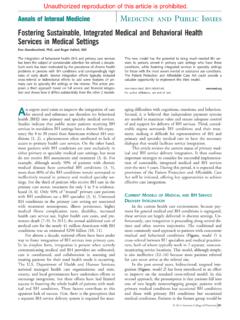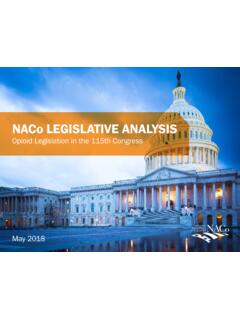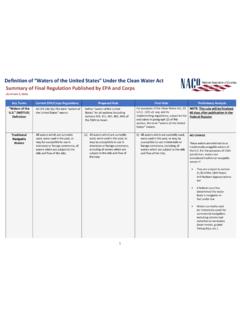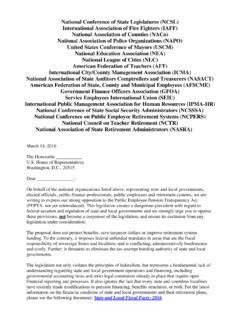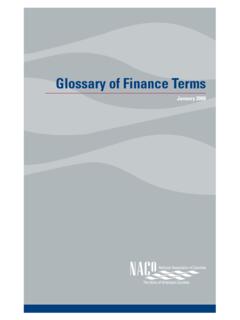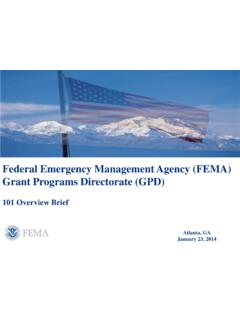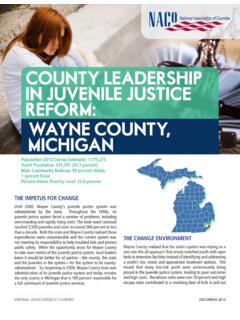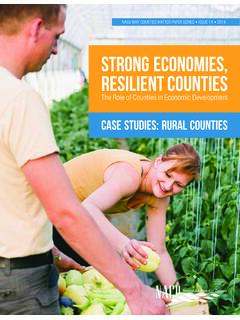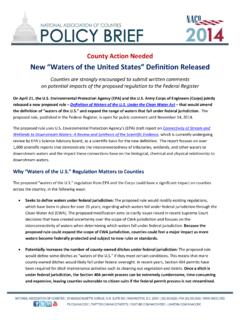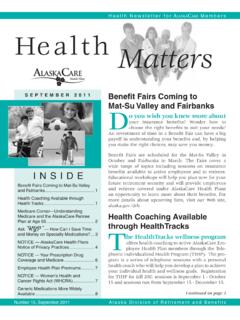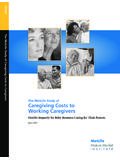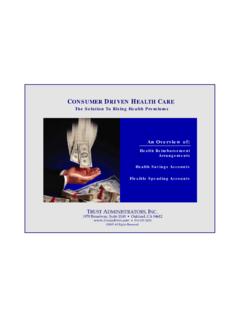Transcription of Youth Aging Out of Foster Care - NACo
1 Youth Aging Out of Foster CareIdentifying Strategies and Best Practices2007-2008 Presidential Initiativeissue briefFebruary 20082007-08 Presidential InitiativeA Publication of the Research Divisionof NACo s County Services DepartmentWritten by Deseree GardnerResearch AssociateFebruary 2008 Youth Aging Out of Foster CareIdentifying Strategies and Best PracticesAbout NACo The Voice of America s CountiesThe National Association of Counties (NACo) is the only national organization that represents county governments in the United States. Founded in 1935, NACo provides essential services to the nation s 3,066 counties. NACo advances issues with a unified voice before the federal government, improves the public s understanding of county government, assists counties in finding and sharing innovative solutions through education and research, and provides value-added services to save counties and taxpayers money.
2 For more information about NACo, visit Presidential InitiativeTable of Contents This issue brief was published in February 2008. For more information regarding this Issue Brief, contact:Deseree GardnerResearch AssociateNational Association of Counties25 Massachusetts Ave. NWWashington DC 20001( (202) 942-4228* ..3 Establishing a Federal Framework ..4 Identifying General Outcomes for Youth Aging Out of care ..5 Strategies to Improve Outcomes for Youth Aging Out of care ..6 Looking Ahead ..8 Conclusion ..8 National Association of CountiesIdentifying Strategies and Best Practices 3 Introduction An estimated 24,000 Foster Youth age out of care each year and attempt to live the last decade the issue of Youth Aging out of the Foster care system has garnered increased at-tention from state and local Specifically, research has focused on how this population of young people has fared after emancipating from the Foster care In June 2007, NACo Presi-dent, Eric Coleman set forth a presidential initiative which addressed the devastating impact3 of Youth Aging out of Foster At the helm of this initia-tive, NACo has partnered with the Pew Charitable Trusts to raise awareness among county officials about the plight of young adults Aging out of Foster care .)
3 With the hope of identifying county practices that support such Youth as they transition to inde-pendent adulthood. According to the Department of Health and Human Services, Administration for Children and Families, children are placed into the Foster care system primarily because of abuse, neglect, un-controllable behavior or dependence. Foster care is intended to be a temporary service,5 with a goal of reunifying children with their parents whenever possible. However, an increasing proportion of children who enter the Foster care system do not achieve reunification with their parents, and live in Foster care until they reach the age of majority, which in most states is 18 years of to the Census Bureau, of the ap-proximately 500,000 children in the Foster care system in the United States, an estimated 24,000 Foster Youth age out of care each year and attempt to live independently.
4 These Youth are expected to succeed on their own long before a vast majority of their peers. The transition to adulthood for Youth who age out of Foster care is burdened with chal-lenges, and more specific supports and services are required to help them overcome extremely difficult circumstances. Not surprisingly, the research that exists on outcomes for Foster care alumni shows that these Youth are at a higher risk for homeless-ness, unemployment, illness, incarceration, welfare dependency, and sexual and physical victimization than their peers. 7 County governments play an important role in the Foster care system and operate the child wel-fare system in 13 While the responsibility of counties in administering the child welfare sys-tem differs among states, all counties in the United States are responsible for providing access to the social safety net that young adults Aging out of fos-ter care need to succeed in their lives and in their communities.
5 County governments are at the fore-front of providing services to former Foster Youth , including access to housing, education, training and job placement, and health first section of this brief will outline the cur-rent federal framework addressing Youth Aging out of Foster care . The second will identify general out-comes for Youth Aging out of care and a third will highlight model county programs and best practices that are addressing the needs of this population in an innovative way. Figure 1: The chart shows the number of children in the fos-ter care system for fiscal years 2000-2005. Source: Depart-ment of Health and Human Ser-vices, AFCARS data Trends: Children in the Foster care System(Number of children per fiscal year)National Association of Counties 4 Youth Aging Out of Foster CareFederal legislation has created a framework for assisting Youth who are Aging out of Foster care .
6 Since 1985 federal law has recognized that older Youth in Foster care deserve funding for special programs and services. In that year, the Indepen-dent Living Program was added to the Social Security In 1999, the law was further amended by the Chafee Foster care Independence Act (FCIA),10 to respond to the limitations and perceived ineffectiveness of the Independent Living Program. The Chafee Foster care Independence Act continues to be the central framework for child welfare The Chafee Bill: Chafee Foster care Independence Program (CFCIP) The Foster care Independence Act, which renamed the Inde-pendent Living Program, the Chafee Foster care Independence Program, expanded eligibility for independent living services to Youth and doubled the funding available to states to provide these services. The CFCIP offers assistance to help current and former Foster Youth achieve self-sufficiency.
7 Funding is offered to states that submit a plan to assist Youth . Under this program, states can use federal funding and matching state dollars to pro-vide support for Youth transitioning from Foster care to inde-pendent Program Overview:Expands eligibility for independent living services to Youth zages 18-21 Provides $140 million in annual funding to states for provid- zing independent living services States are required to contribute 20 percent in matching funds. zMany states and localities choose to supplement CFCIP zfunds with their own dollars, or private receive funds, states must provide written transitional in- zdependent living plans based on the needs of each Youth . Gives states flexibility to decide what services they will pro- zvide with the funds they The Chafee Education and Training Vouchers Program (ETV)The Chafee ETV program makes financial resources avail-able to meet the post secondary education and training needs of Youth Aging out of Foster care and enrolled in a qualified higher education Overview:Authorizes $60 million in discretionary payments to states zfor post-secondary educational and training vouchers for Youth who age out of Foster vouchers up to $5,000 per year, per Youth for post zsecondary The Chafee OptionCurrently, states provide health care for children and Youth who are in Foster care through Medicaid.
8 However, upon ex-iting care , Youth typically lost their eligibility for Medicaid coverage, leaving many uninsured. In an attempt to provide a bridge between their Medicaid coverage as children and their coverage as young adults, states have used various mechanisms to extend Medicaid coverage for this population. In 1999, the Foster care Independence Act was signed into law. The legisla-tion included an option for states to extend Medicaid coverage to Foster Youth up to age 21. Program Overview:Allows states to extend Medicaid coverage for Youth who zhave aged out of care up to the age of Family Unification Program (FUP)Funded by the Department of Housing and Urban De-velopment, the FUP offers housing assistance and transitional assistance for Youth who age out of care . Funds are provided to agencies that referred Youth to the program.
9 Program Overview:Provides time limited housing vouchers to eligible Youth be- ztween the ages of 18 and 21 who left Foster care after age 16. 5. YouthbuildAuthorized as the Hope for Youth , program in 1992, un-der the Housing and Community Development Act of 199214, Youthbuild provides grants on a competitive basis to assist high-risk Youth between the ages of 16-24 to learn housing construction job skills and to complete their high school educa-tion. Program participants enhance their skills as they construct and/or rehabilitate affordable housing for very low income, and homeless persons or families. During the past 7 years, HUD has released more than $300 million in grants to Youthbuild programs around the Overview:Awards competitive grants to state and local governments or zany organization eligible to provide education and employ-ment training under federal employment training programs.
10 Applicants must submit specific information about a pro- zposed project in their Categories: zCategory 1- Reserved for new applicants. Grants are avail- able for $400,000 or less for activities not to exceed 30 monthsCategory 2- Grants are available for $700,000 or less for activities not to exceed 30 3- Grants are available for $400,000 or less to establish programs in underserved and rural areas not to exceed 30 months. This section has described the federal framework ad-dressing the issue of Youth Aging out of Foster care . The next section will identify general outcomes which con-front this a Federal Framework National Association of CountiesIdentifying Strategies and Best Practices 5 Foster Youth who age out of care are more susceptible to el-evated rates of homelessness, poor educational outcomes, low wages, unemployment, health issues, and incarceration ac-cording to the Midwest Evaluation of the Adult Functioning of Former Foster Youth Study ( Midwest Study ),17 conducted by the Chapin Hall Center for Children at the University of Chicago, in 2007.
